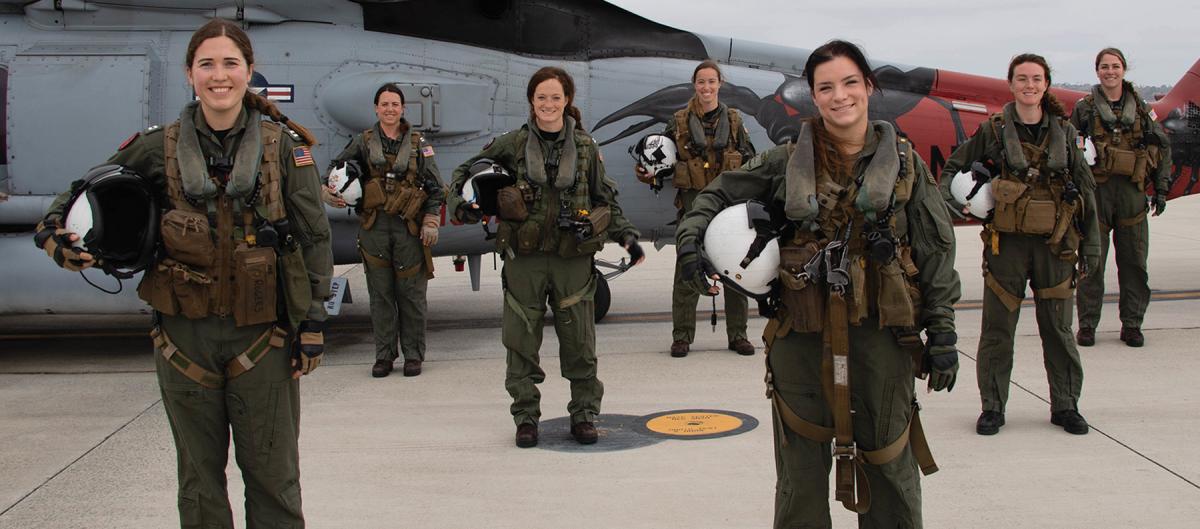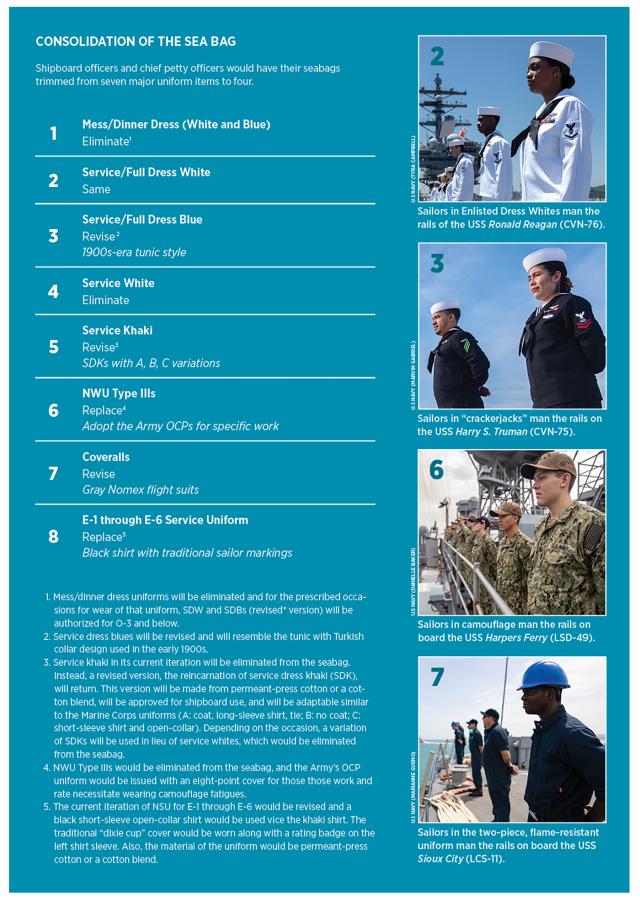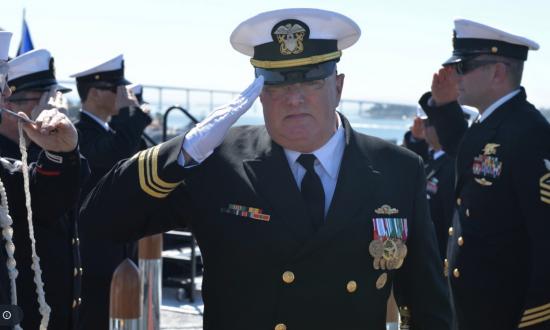In the early 2000s, the Navy rolled out its version of camouflage utilities, or Type I Navy Working Uniform (NWU), colloquially know in the fleet as “aquaflage” or “blueberries.” It was a half synthetic, half heavy cotton uniform that E-1 through O-10 could wear on shore or ships. The uniform was supposed to be functional, conceal small amounts of paint and oil, and appeal to a younger recruiting base for the Navy. Unfortunately, it was not flame retardant. The Type I NWUs were sidelined for underway use and hastily replaced in 2014 with fire-retardant blue coveralls. In 2018, the Type Is were officially phased out and replaced with the Type III NWUs, a uniform previously approved exclusively for desert or other (non-shipboard) groundwork.
Although the entire fleet has transitioned to Type IIIs, this uniform is still not approved for shipboard use, as the synthetic-cotton blend is the same as the Type Is. So, now the fleet has a uniform to wear while ships are moored and while working in an office setting. At no time has anyone asked, “What uniform is truly the most applicable for sailors, during both shipboard and shore duty?” The Navy needs to prioritize consolidating the seabag, making uniforms practical while still honoring the service’s rich tradition.
Focus on Shipboard Uniforms
Recognizing the changed environment and with an eye toward the Navy’s history, the fleet recently transitioned from the “Don’t Tread on Me” Navy Jack back to the Union Jack. The same must be done for uniforms to create a seabag that is both functional and affordable. Camouflage uniforms need to be eliminated from the seabag for surface and submariner sailors. Fire protection is critical, and sailors should be issued gray Nomex flight suits as part of their organizational clothing. The uniforms are practical, provide fire protection, and are lightweight and durable. The gray color is enough to distinguish that a sailor is not an Airdale, but instead is part of the surface or submarine forces.
In addition to gray “flight” suits, the fleet needs to adopt a single, year-round uniform for officers, chiefs, and E-6s and below. These new uniforms would be made from permanent-press cotton or a cotton blend to retain some fire-protection capabilities. For officers and chiefs, another attempt to bring back the service dress khaki (SDK) uniform should be undertaken. There should be three variations of wear: A, B, and C versions, similar to the Marine Corps. The A would be a long-sleeve khaki shirt, black tie, and khaki coat, the B would be a long-sleeve shirt and tie with no coat, and the C would be a short-sleeve, open-collared shirt. This iteration of SDKs would replace the current standard of wear for Type IIIs and summer whites. Eliminating summer whites is necessary to cut down on the seabag and to create better parity between officer/chief uniforms and E-6 and below. The prescribed variation of SDK (A, B, or C) would suffice in lieu of summer whites, e.g., for a ship or submarine going to or returning from deployment, promotion ceremonies, etc.
For E-6 and below sailors, another uniform that requires revision is the current iteration of the Navy Service Uniform (NSU). The infamous “peanut butters,” or “black and tans,” is in desperate need of revision. E-6 and below sailors should have a year-round service uniform they can wear for shipboard and office use.
To accomplish this, the current NSU needs to be revised to be made with a permanent-press cotton or a cotton blend certified for shipboard use, and the shirt and trousers both black in color. Also, for sailors to be recognized as such and not as part of another military branch, they should go back to wearing a “dixie cup” cover with this set of NSUs and a rating badge with a black background on their left sleeve.
A Practical Application of Dress Uniforms
There are too many variations of dress uniforms, presenting an opportunity to further reduce the seabag for officers and chiefs. To move forward with this proposal, the practice of having myriad dress uniforms for civilian-equivalent wear must be ended. The mess and dinner dress uniforms, both white and black, should be eliminated from the uniform list. The uniform regulations should be revised to accept that a “Turkish” collar uniform meets the intent of a bow tie for the proper setting and level of respect for any formal occasion. This is already allowed for O-3 and below, as the mess dress uniform is only required for O-4 and above, an exception that defies the intent of uniforms in the first place. Uniforms are meant to be uniform, so the Navy should embrace uniformity and reject the concept of an optional uniform for junior ranks and a required uniform for middle to senior ranks.
To facilitate removal of the mess and dinner dress uniforms, a revision of the current iteration of service dress blue (SDB) is needed. To conform to a more formal use of the service dress uniforms—“choker whites” and SDBs—SDBs would need to reflect the World War I–era and pre-World War I era predecessor uniforms. Specifically, the uniform top would be a black tunic rather than the current double-breasted black suit coat—this would mean that SDB “bozo” (SDBs with a bow tie and mini medals) would be a thing of the past. The current version of choker whites and the revised SDBs, or “choker blues,” would be worn by E-7 and above. For occasions that necessitate a civilian equivalent for a black-tie event, E-7 and above would wear mini-medals and insignia like O-3 and below do now. Essentially, these two versions of dress uniforms—used during the appropriate warm and cold climates—would replace or continue to be worn during occasions that call for dinner/mess dress (mini-medals and insignia), formal dress (large medals and regular insignia), and service dress (ribbons and regular insignia).
Admittedly, this proposal would be controversial, as there are members who are excessively fond of their mess dress uniforms and their SDBs. The current version of SDBs is indeed iconic with a history of its own, but it is necessary to consolidate two seasonal formal/service/dress uniforms.
Camouflage for Camouflage Jobs
Finally, the Navy needs to adhere to the 2014 National Defense Authorization Act and adopt one of the other services’ camouflage uniforms. The Navy needs to order the same camouflage utilities as the Army and commission the manufacturer to make an eight-point cover. This will leave the Marine Corps as the lone service with a different camouflage uniform than the other services. In addition to adopting the Army’s version of camouflage utilities, the Navy should make that uniform organizational clothing and issue it only to the forces that would need it, e.g., SEALs, SeaBees, beach-unit personnel, master-at-arms on shore duty, and other units whose primary duty is expeditionary. This reversal of camouflage uniform policy is consistent with recognizing the Navy is back to being a seagoing force with near-peer competitors on the high seas.
While not a panacea for the uniform woes of our seagoing service, these proposals provide a jumping-off point for improving Navy uniform policy. The proposals recognize the Navy’s heritage as a seagoing force, and with the use of new textile materials and manufacturing, can make Navy uniforms practical, more comfortable, and still professional in appearance. Navy leaders have an obligation to cut costs where possible and provide sailors with uniforms that make sense and respect the Navy’s long history.







